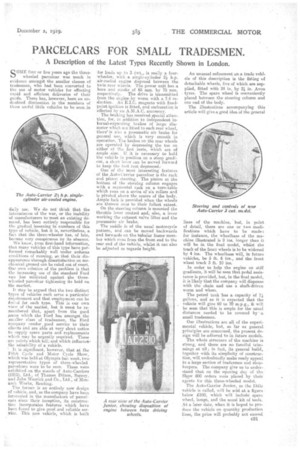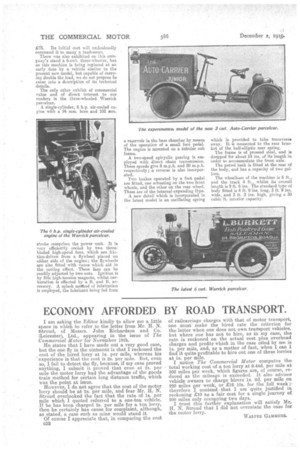PARCELCARS FOR SMALL TRADESMEN.
Page 19

Page 20

If you've noticed an error in this article please click here to report it so we can fix it.
A Description of the Latest Types Recently Shown in London.
SOME four or five years ago the three wheeled pareelear was much in evidence amongst the smaller classes of tradesmen, who had been converted to the use of motor vehicles for effecting rapid and efficient deliveries of their goods. There has, .however, been an undoubted diminution in the numbers of these useful little vehicles to be seen.in daily use. We do not think that the intermission of the war, or the inability of manufacturers to meet an existing demand, has been entirely responsible for the gradual lessening in numbers of this type of vehicle but it is, nevertheless, a fact that the three-wheeler has, of late, became very conspicuous by its absence.
We knew, from first-hand inlorreatioq, that many vehicles of this type have performed remarkably well under arduous conditions of running, so that their disappearance through dissatisfaction en mechanical ground can be ruled out of court. Our own solution of the problem is that the increasing use of the standard Ford van has militated against the threewheeledparcelear tightening its hold. on the market.
It may be argued that the two distinct types of vehicles each sow &particular requirement and that employment ran be found for each type. This is our own view of the matter, but it must be remembered that, apart from the good game which the Ford has amongst the smaller class of tradesmen, the Ford Company render good service to their clients and are able at very short notice to supply spare parts and replacements -which may be urgently required. These -are points which tell,and which infittence• the saleability of a vehicle. '
it is significant, however, that at the Fifth Cycle and . Motor Cycle Show, which was held at Olympia last week, two representative types of three-wheeled pareelcars were to he seen. These were exhibited on the stands of Auto-Carriers (1911), Ltd., of Thames Ditton, 'Surrey, and John Warrick and Co., Ltd., of Monarch Works, Reading.
The former is an entirely new design of vehicle, and, as the company have been interested in the manufacture of parcelears since their inception, its constrnetion incorporates features which have been found to give good and reliable sexyiee. This new vehicle, which is built for loads up to 3 divt.,.is really a fourwheeler, with a single-cylinder 2 h.p. air-cooled engine disposed between the twin rear wheels. The power unit has a bore and stroke of 65 nun. by 75 nun. respectively. The drive is transmitted from the engine by worm with a 7.4 reduction. An E.I.C. magneto with fixedpoint.ignition is fitted, and carburation is effected by en A.M.A.C. accessory.
The 'braking has received special attention, for, in addition to independent internal-expanding brakes of large diameter which are fitted to each rear wheel, thereis also a pneumatic air brake for general use, which is very smooth in operation. The brakes on the rear wheels are operated by depressing the toe on either of the foot rests, which are of ample size. If. it is necessary to hold the vehicle in position on a steep gradient, a short lever can be moved forward to keep the loot rest depressed,. One of the most interesting features of the Auto-Carrier parcelcar is the rack and pinion .steering. The pinion at the bottom of the steering column engages with a segmental rack on a turn-table which runs on a series of -six rollers and is pivoted above the centre of the body. Ample lock is provided when the wheels are thrown over to their fullest extent.
On the steering column is mounted the throttle lever contra and; also, a, lever working the exhaust valve lifter and the pneumatic air brake.
The saddle is of the usual motorcycle pattern, and can be moved backwards and forwards on the tubular frame member which runs from the front end to the near end of the vehicle, whilst it can also be adjusted as regards height. An unusual refinement on a trade vehicle of this description is the fitting of detachable wheels, five of which are supplied, fitted with 24 in. by 21 in. Avon tyres. The spare wheel is conveniently placed between the steering column and 011e end of the body.
The illustrations accompanying this article will give a good idea of the general lines of the machine, but, in paint of detail, there are one or two modifications which have to be made: for instance, the wheelbase of the machine illustrated is 9 ins, longer than it will be in the final model, whilst the track of the front wheels is to be widened by 4 ins. The wheelbase will, in future vehicles, be 5 ft. 6 ins., and the front wheel track 3 ft. 10 ins.
In order to help the engine on stiff gradients, it will be seem that pedal assistance is provided, but, in the final model, it is likely that the company will dispense -with the chain and use a shaft-driven worm and wheel..
The petrol tank has a. capacity of lk gallons, and as it is expected that the vehicle will give 60 to 70 m.p.g., it will be seen that this is ample for the uSual distances needed to be covered by small tradesman.
Our illustrations are all of the experimental vehicle, but, so far as general principles are concerned, the present design will be adhered to in future models.
The whole structure of the machine is strong, and there are no fanciful trimmings at all ; in fact, its general build, together with its simplicity of construction, will undoubtedly make ready appeal to a large section of tradesmen and shopkeepers. The company give us to understand that on the opening day of the Show 800 orders were placed by their agents for -this three-wheeled model.
The Auto-Carrier Junior, as the little vehicle is called, will be sold at a figure below £100, which will include spare wheel, lamp., and the usual kit of tools. At a later date, when it is hoped to produce the vehicle on quantity production lines, the price will probably not exceed
£15. Its initial cost will undoubtedly commend it to many a tradesman. There was also exhibited on this company's stand a 6-cwt. three-wheeler, but as this machine is being replaced at an early date by a vehicle similar to the present new model, but capable of carrying double the load, we do not propose to enter into a description of its technical details.
The only other exhibit of commercial value and of direct interest to our readers is the three-wheeled Warrick parcelcar.
. A single-cylinder, 6 h.p. air-cooled engine with a 94 mm. bore and 102 mm.
stroke comprises the power 'unit. It is very efficiently cooled by two thnebladed high-speed fans, which are friction-driven from a flywheel placed on either side of the engine; the flywheels are also fitted with vanes which aid in the cooling effect. These fans can be readily adjusted by two nuts. Ignition is by 13lic high-tension magneto, whilst carburation is effected by a B. and B. accessory. A splash method of lubrication is employed, the lubricant being fed from a reservoir in the base chamber by means of the operation of a small foot pedal. The engine is mounted on a tubular sub frame.
A two-speed epicyclic gearing is employed with direct chain transmission. These speeds give 8 m.p.h. and 20 m.p.h. respectively; a reverse is also incorporated.
Two brakes operated by a foot pedal are fitted, one actuating on the two front wheels, and the other on the rear wheel. These are of the internal-expanding type. A new detail which is incorporated in the latest model is an oscillating spring
which is provided to take transverse i sway. It s connected to the rear bracket of the half-elliptic rear spring. The frame is of pressed steel, and is dropped for about 14 ins, of its length in order to accommodate the front axle.
The petrol tank is fitted at the rear of the body, and has a capacity of two galIons.
The wheelbase of the machine is 6 ft., and the track 4 ft., whilst its overall length is 9 ft. 6 ins. The standard type of body fitted is 4 ft. 9 ins, long, 3 ft. 9 ins. wide. and 3 ft. 2 ins, high, giving a 30 cubic ft. interior capacity.


























